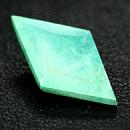|
|
||||||||||||||||
|
||||||||||||||||
|
||||||
|
|
|
|
Aurichalcite
|
|
| | |
| Discovered in 1839; IMA status: Valid (pre-IMA; Grandfathered) | ||
|
| ||
|
Chemistry |
|
|
| |
|
(Zn,Cu)5(CO3)2(OH)6 | |
|
|
Zinc Copper Carbonate Hydroxide |
|
Molecular Weight: |
546.71 gm |
|
Composition: |
Zinc |
44.85 % |
Zn |
55.83 % |
ZnO |
|
|
Copper |
14.53 % |
Cu |
18.19 % |
CuO |
|
|
Hydrogen |
1.11 % |
H |
9.89 % |
H2O |
|
|
Carbon |
4.39 % |
C |
16.10 % |
CO2 |
|
|
Oxygen |
35.12 % |
O |
|
|
|
|
|
100.00 % |
|
100.00 % |
= TOTAL OXIDE |
|
|
|
||||
|
Classification |
|
|
| |
|
Carbonates | |
|
5/C.01-110 | |
|
|
5 : CARBONATES (NITRATES)
|
|
Related to: |
n/a |
|
Varieties: |
None |
|
Synonyms: |
Auricalcite, Auricalcocita, Aurichalcita, Blue Calamine, Buratite, Messingite, Orichalcite, Risséite |
|
|
|
|
Crystal Data |
|
|
|
|
|
As acicular to lathlike crystals with prominent {010}, commonly striated || [001], with wedgelike terminations, to 3 cm. Typically in tufted divergent sprays or spherical aggregates, may be in thick crusts; rarely columnar, laminated or granular. |
|
|
Observed in X-ray patterns. |
|
|
|
|
|
Physical Properties |
|
|
|
|
|
Perfect on {010} and {100} |
|
|
Irregular/Uneven |
|
|
Fragile |
|
|
1.0 - 2.0 |
|
|
3.96 (g/cm3) |
|
|
None |
|
|
Not Radioactive |
|
|
Other: |
Soluble in acids and in ammonia. |
|
|
|
|
Optical Properties |
|
|
|
|
|
Pale green, greenish blue, sky-blue; colorless to pale blue, pale green in transmitted light. |
|
|
Transparent |
|
|
Silky to Pearly |
|
|
1.655 - 1.744 Biaxial ( - ) |
|
|
0.089 |
|
|
Relatively strong; r < v |
|
|
Weak; X = Colourless, Y = Blue-green, Z = Blue-green |
|
|
|
|
|
Occurances |
|
|
|
|
|
Geological Setting: |
A secondary mineral in oxidized zones of copper and zinc deposits, typically as crusts. |
|
Common Associations: |
Rosasite, Smithsonite, Hemimorphite, Hydrozincite, Malachite, Azurite |
|
Common Impurities: |
Ca |
|
Type Locality: |
Loktevskoye (Loktevskii) Mine, Upper Loktevka River, Rudnyi Altai, Altaiskii Krai, Western-Siberian Region, Russia |
|
Year Discovered: |
1839 |
|
View mineral photos: | |
|
|
|
|
More Information |
|
|
|
|
|
| |
|
|
|
|
Distribution: Widespread in small amounts. Localities noteworthy for good specimens include: from the Loktevskii mine, upper Loktevka River, west Altai Mountains, Russia. At Monteponi, and in the Rosas mine, Sulcis, Sardinia, Italy. From Laurium, Greece. At Chessy, near Lyon, Rhône, France. In the USA, in Arizona, fine examples from Bisbee, Cochise County, in the Silver Hill mine, Pima County, and at the 79 mine, Gila County; from Cerro Gordo, Inyo County, California; at the Kelly and Graphic mines, Magdalena, Socorro County, New Mexico. In Utah, from the Tintic district, Juab County, at the Hidden Treasure mine, Tooele County, in the Apex mine, near St. George, Washington County, and from Big Cottonwood Canyon, Salt Lake County; at Leadville, Lake County, Colorado. In Mexico, rich specimens from the Ojuela mine, Mapimí, Durango, Mexico. At the Tchah Khuni mine, Anarak district, Iran. From Tsumeb, Namibia. At Kipushi, 28 km southwest of Lubumbashi, Katanga Province, Congo (Shaba Province, Zaire).
|
|
|
We
have not photographed our Aurichalcite gems yet. Please
check back soon. |
